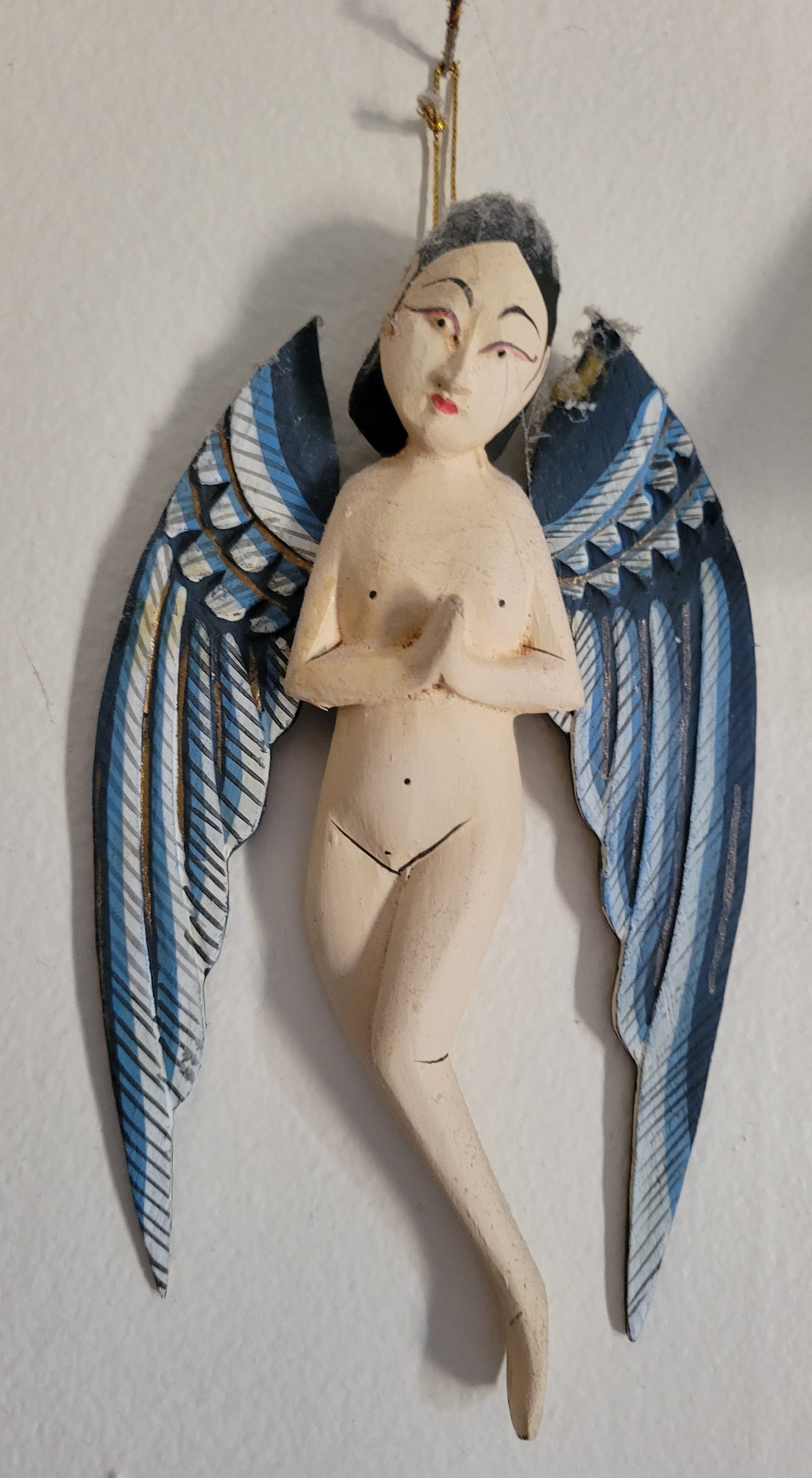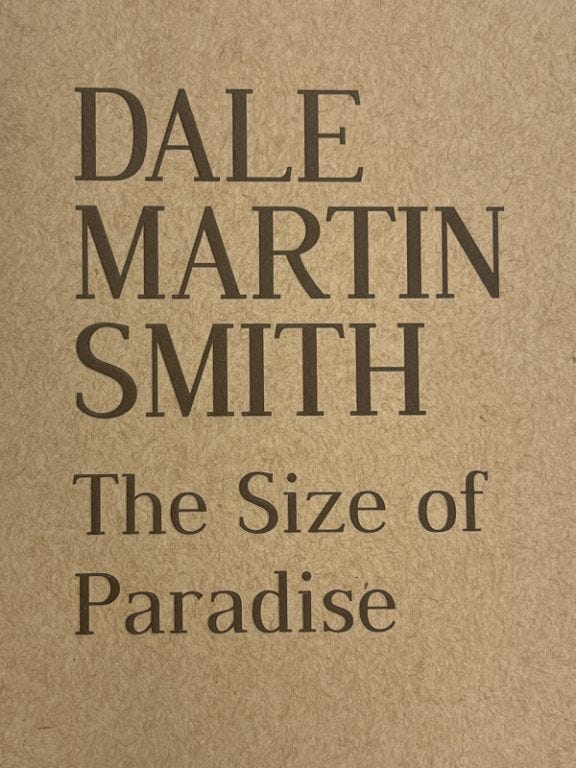Dale Martin Smith “Notes On Paradise”
Essay | The Size of Paradise Longlisted for the 2025 Griffin Poetry Prize
Poet Peter Gizzi writes of The Size of Paradise:
“The momentum of this capacious book-length sequence keeps turning outward as it investigates an inward subjectivity, not all together Dale Smith per se, but maybe a collective interiority where we find, ‘Dead things collect in words.’ And more importantly we discover ‘There will be love as memory.”
Dale Martin Smith “Notes On Paradise”
An April 7, 2020, obituary for John Prine who died of Covid-19, reported that the songwriter loved telling stories about his work, but often with some reservation: “When I wrote this,” he said, “I stayed in my room for three days. I was afraid someone was going to ask me what the song was about.”
Writing these notes for The Size of Paradise draws me into the open, prodding me to confront the nebulous issue of the about. I spent a year beginning in fall 2015 writing daily after work, usually in taverns, parks, or quiet nooks of my house, always in prose, listening to the environments around me. Slowly certain figures, characters, voices, images, moods, visionary states, places and devotional energies emerged. There is a Balinese Angel, for one, a small wooden figure that hangs in a corner of my room. I discovered tensions in domestic and public spaces that entered the poems through the characters of Emily Dickinson and that crowing bard, Walt Whitman. Crows, sparrows, cuckoos, and other figures of orientation returned throughout the writing to both ground and move perception. These familiar images established modes of insight and transformation, shifting as I wrote. They suggest place as variant, animated by migratory creatures, from the Carolinian Woodlands of the United States and Canada to the European song and lore of trans-Atlantic, balladic crossings—Harry Smith’s Anthology of American Folk Music (1952) is always present. Although most of the writing here generated from locations in Ontario, Texas, and Maryland, I drew on converging sources of memory, imagination, and daily news streams, devoting attention to conditions revealed in an assemblage of words. Shiloh occurred as an ongoing violence I derived from global report and commentary (the Battle of Shiloh [April 6-7, 1862] left more than 3,000 soldiers dead and many more wounded in rural Tennessee). Time seemed to stack up with images, moods, visions, and spiritual entities, recalling for me Walter Benjamin’s well-known description of Paul Klee’s Angelus Novus. In this angelic figure, Benjamin “sees one single catastrophe which keeps piling wreckage upon wreckage and hurls it in front of his feet.”
There was a story. There was a time. There was a distinct sense of measure. There was a heat. But never calm. Messiness. Wide oak. How plastic lids exhale carbon. Consume the gaze. Each arm smooth and dispatched. Skull heart stands in lonely fiddler corner. One might crave honey sweetness or dare uncommon sanctimony. Oppose the dark corner dryly. Across a runway distance, leaves of the city spangle, surprise. Sip warm cups of berry tea and lime. See tangled stems adhere to her eyes. Lean absently against the pear. Then weep in ancient doorways as people come and go.
An excerpt from DALE MARTIN SMITH’s The Size of Paradise (p.9)
The sonnet’s traditionally acknowledged origin in Western culture via the polyglot Sicilian court of Frederick II (1194-1250) may have been preceded in Arabic-speaking Spain by the muwashshah, a form of poetry and a musical genre. The Italian sonetto, a diminuitive of sono, a sound, tune (Latin sonum), carries over the lyric sounding (sonata) often retained in English sonnets, even those like Ted Berrigan’s or Bernadette Mayer’s that are decidedly, formally, experimental and non-standard. I restricted my sonnets to roughly ten syllables per line. I listened for what sounded out of my prose notes, and oriented my attention to the sonnet’s gravitational pull while searching for what had been latent in my writing. What does imposed form require? How does rhythm manifest meaning? I sought to establish a relationship between the raw data of perception (and reception) and the formal obligation to the song, those sounds bodying through time, across continents. I also began working with the sonnet as a way to acknowledge the teaching of Tom Clark, who showed me long ago how to listen to poetry rather than only to what I thought I might want to say.
Finally, John Milton in Book 9 of Paradise Lost illustrates a first wounding. The size of paradise might only be known by all the dead. Or we make what we can of the world by each sounding or breath. The uprising of certain order, certain careful devotions, makes possible the realities we most desire. “And the blackness says we begin a new cosmos,” writes Alice Notley. My devotional sonnets assemble little pieces moving through time and non-time, to configure what’s going on. With Notley,
I want POWer to fill this MY VOID of no size in no space
Where there is ALL of NO space I am a BROken WINDow
The Size of Paradise by Dale Martin Smith knife | fork | book, 2024 Distributed by Asterism Books
Dale Martin Smith is a poet, editor, literary scholar, and professor at Toronto Metropolitan University. He is the author of the poetry collections The Size of Paradise, Flying Red Horse, Slow Poetry in America, Black Stone, American Rambler, as well as the Knife Fork Book chapbooks, Sons, and Blur. Born in Dallas, he earned a BA and PhD in English from the University of Texas, and an MA in Poetics from New College of California. Smith’s scholarly contributions include Poets Beyond the Barricade: Rhetoric, Citizenship, and Dissent after 1960 and two edited editions, An Open Map: The Correspondence of Robert Duncan and Charles Olson and Imagining Persons: Robert Duncan’s Lectures on Charles Olson. His essays and poetry have appeared in Poetry, The Walrus, LA Review of Books, Boston Review, and Lambda Literary. With Hoa Nguyen, he edited Skanky Possum, a literary zine and book imprint, from 1998 to 2004. His essay collection, That Tongue Be Time: Norma Cole and a Continuous Making, is forthcoming from University of New Mexico Press.
Support Send My Love to Anyone
Support Send My Love to Anyone by signing up for a monthly or yearly subscription, liking this post, or sharing it
Big heartfelt thanks to all of the subscribers and contributors who make this project possible!
Connect
Bluesky | Instagram | Archive | Contributors | Subscribe | About SMLTA






